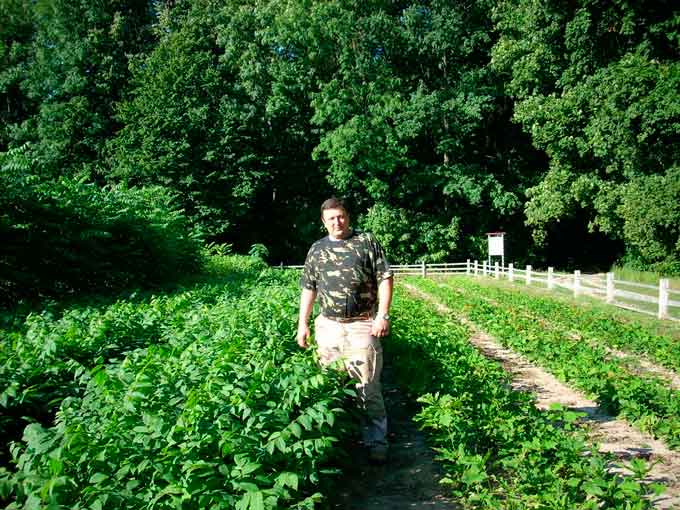The tumultuous economy of the 1990 s affected Ukrainians in very different ways: some lost virtually all they had, succumbing to panic and depression, but others seemed to quickly navigate among new opportunities and reorient to new markets. Anatoliy Pohrebniak, head of Koopzovnishtorh Enterprise, managed to keep the business ties he had established during Soviet times, and developed a lucrative business in Cherkasy, collecting, processing and exporting agricultural crops. The mainstay of his export business was not wheat, barley or sunflowers, as would be typical among Ukrainian agricultural exporters, but rather pumpkin seeds and walnuts. Opponents of Ukrainian ties to the EU decry the lack of competitiveness of many Ukrainian products, but the quality of Cherkasy walnuts is so high that they have been served at Dutch royal tables for over 20 years.
Food for astronauts
It is well known that the possession and sale of foreign currencies in the former Soviet Union were criminally prosecuted. However, there were those in Cherkasy who dealt in hard currency flows quite legally. The trade cooperative Sozuykoopzovnishtorh, and its representatives in Cherkasy in particular, did so in connection with the agricultural products and medicinal plants they exported to Europe, North Africa, and Japan.
Only two regions of Ukraine (Cherkasy and Khmelnitsk) had direct connections with the Soviet export-import trading cooperative Sozuzkoopzovnishtorh — and that was because they provided the largest share of Soviet exports. Cherkasy alone accounted for almost 5% of total exports.
''However, with the collapse of the Soviet Union, Soyuzkoopzovnishtorh disappeared and no one was in a hurry to replace it in Ukraine. So I took the initiative to create a private joint stock company, Koopzovnishtorh, that allowed us to keep and further develop a network of business contacts—and that in the process was providing two hundred jobs,” Anatoliy Pohrebniak told Nova Doba.
In Soviet times, the Cherkasy Oblast exported pumpkin seeds, walnuts, chestnuts, fruit and berries, as well as medicinal plants, including Tatar potions and the “plant-parasite,” mistletoe. Five factories in Cherkasy processed those products, and one of them, the Uman experimental cannery, produced food for the first Soviet cosmonauts.
Initially, Koopzovnishtorh tried to continue exporting the entire range of Soviet-era products, and by entering the Ukrainian Grain Association, exported sunflowers, wheat, barley, and even fertilizers. But over time it chose to stick with only the most promising and profitable crops.
This turned out to be walnuts, also called Greek nuts in Ukrainian -- which actually grow in Ukraine.
‘In 1997,” recalls Pohrebniak, “no one believed that you could amass a collection of nuts in large volumes. We started out small – 18 tons, but quickly increased production up to 600--700 tons per year, and most recently up to one thousand tons.”
“Considering that shelled walnuts on the world market are worth $ 3-3.5 per kilogram, this can be a very profitable business, if you successfully develop commercial nut orchards, reduce tax pressures, and remove the corruption component,” he adds.
Let’s Go to a Walnut Orchard
Today, Ukraine may not boast serious walnut plantations. Its 2,500 hectares is significantly less than Moldova’s 14,000. And it is far behind the more serious players in the business, such as the USA.
As explained by Pohrebniak, “Ukraine is in the top 10 exporters of shelled walnuts. The first three are the USA, Canada and China, followed by Japan, France and Türkiye. Moldova is growing dynamically, which is gradually pushing us from the market. This is very annoying because, without a corresponding governmental policy, Ukraine could very quickly lose its share on the world market.”

What prevents Ukraine's walnut business from evolving?
Pohrebniak almost never mentions problems with foreign partners. The main problems are the significant tax burden and the black market, which makes the products of honest entrepreneurs less competitive.
“To work with foreign partners,” he says, “is a real pleasure. They adhere to legal requirements and keep their word. For twenty years we have been working with Agrìcol-Sammy, an Italian company, Yarden, a large French processing company, and Rabat end, another French company, which has offices in Syria and Lebanon in association with the Austrians and the Dutch. In difficult times, when we did not have enough resources, we negotiated with foreign partners over prepayment and they tried to fulfill all their obligations. The real problems are Ukraine’s flawed legal framework and questionable export schemes that allow about half of our nuts to be smuggled into Türkiye, Syria, and Russia.”

Mr. Pohrebniak considers the period from 1995 to 2009 as the best years for his enterprise. During that time, the company invested about a million hryvnias annually into development, purchasing four isothermal rooms and fully equipping them. Now the processing, sorting and calibration of nuts is carried out at two production facilities. And while the number of workers at the enterprise has been significantly reduced, the company has been trying not only to sustain its current volume of production for export but to actually increase it.
'' Now I employ only 15 workers. Of course, some operations are performed by machines. At the same time, a machine that sorts the nuts by color costs half a million euros," he says.
However, sorting nuts is a delicate operation. In most stages this is a manual work, because the machines do not provide the desired quality.
Overall, the company owns five sorting machines, with which workers cleanse the nuts from impurities and additives (in accordance with European standards, 10 kg of nuts must contain no more than 4-8 grams of shell; and, of course, rot and gaps between the 'butterfly' halves are unacceptable).
Next comes sorting by sizes, which may vary according to a scale of 20 indicators, including 'butterfly' halves, quarters, eighths and crumbs.
The nuts are also sorted by color. The accepted color spectrum consists of 10 shades, from straw to coffee.

Cleaned, calibrated and packed nuts must be certified by health and quarantine services and must receive a certificate of origin. Samples are first sent to Europe, and, after negotiating with foreign partners, the main supply of the goods is then exported.
“The pickiest experts in the process of checking the quality of the finished products are our partners from Germany and Austria, but even from them any complaints are rare,” says Mr. Pohrebnyak.
A proposal from the Netherlands has even been made to award products from Koopzovnishtorh a "Quality Mark" because nuts from Cherkassy are on the menu at even the Dutch Royal Court.
“Our nuts are used for making exclusive pastry products and expensive cheeses. Usually it takes about 720 to 800 halves to constitute one kg of final product,” says Mr. Pohrebniak.
Nuts grown in Cherkasy are environmentally friendly, and manual cleaning, sorting and sizing allows them to compete with similar products in Europe and America. However, the lack of state subsidies is a problem—it’s an obvious disadvantage in comparison with European competitors who regularly have the financial support of their governments.
In Europe not only is the cultivation of grain subsidized, but also the cultivation and processing of pumpkin seeds and the commercial harvesting of nuts. By contrast, in Ukraine, unlike farms in many European countries, growers are subject to an additional layer of taxation.
This situation encourages more and more farmers to sell their nuts to black market intermediary buyers, who smuggle them abroad without going through customs. As a result, not only do legitimate Ukrainian export operators suffer, but the country’s treasury suffers the loss of thousands of dollars in lost tax revenues.
Our prospects
Based on their experiences with their European colleagues, Cherkasy farmers and export businesses have not lost hope in their goal to pursue their businesses honestly and successfully. These hopes in fact led Cherkasy residents to found the All-Ukrainian Walnuts Association.
The current annual production of walnuts in Ukraine (taking into consideration only those areas that are currently in use) is estimated to be 70,000-80,000 tons. Officially, however, only about 15,000-20,000 tons go through customs. With a hundred seedlings per hectare, a farmer should be able to generate annual revenues of approximately USD 4,000-5,000, and nuts do not require care as thorough or expensive as do other crops.
Today a portion of Ukraine’s nut production is sold on the domestic market, mostly to confectionery and bread bakeries in Rivne and Lviv. Some private business owners of small cafes and restaurants buy them too. However, the European market remains a priority. According to Mr. Pohrebniak, “I am already 30 years in this business, but now (after signing the Association Agreement with EU) new horizons are opening up and, consequently, everything is just beginning.”




